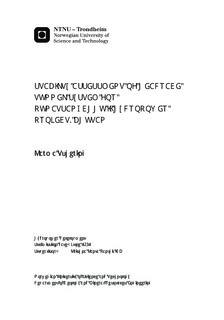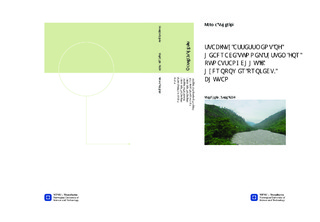| dc.contributor.advisor | Panthi, Krishna Kanta | nb_NO |
| dc.contributor.author | Tshering, Karma | nb_NO |
| dc.date.accessioned | 2014-12-19T11:55:40Z | |
| dc.date.available | 2014-12-19T11:55:40Z | |
| dc.date.created | 2013-02-06 | nb_NO |
| dc.date.issued | 2012 | nb_NO |
| dc.identifier | 603562 | nb_NO |
| dc.identifier | ntnudaim:7488 | nb_NO |
| dc.identifier.uri | http://hdl.handle.net/11250/236060 | |
| dc.description.abstract | Bhutan is a small Buddhist country nested in the cradles of the eastern Himalayas. It has rugged mountainous terrains with altitudes ranging from 500 masl in its southern plains to 4500masl in the snowy capped mountains in north. This rugged mountainous topography blessed Bhutan with huge hydropower potential. The hydropower potential of Bhutan is estimated at 30000MW with projects above 10MW capacity as per the power system master plan. This is one of the highest in the world considering its small size. In absence of other valuable natural resources, hydropower has become the main national resources in the country. Out of huge potential, Bhutan today has 1488MW of installed hydropower project under generation illuminating about 90% of all houses in the country and feeding power to its developing industries. Because of its small size and even smaller population, the internal electricity consumption of Bhutan is small roughly 30% of its present generation. The balance power is exported to India generating the most needed revenue for the economic development of the country. Bhutan plan to construct 10000MW of hydropower projects within year 2020 among which some mega projects are already under construction.Bhutan being located in the tectonically active Himalayan geological formation faces lots of geological challenges in tunneling works. The Himalayan geology intruded by numerous geological discontinuities, and frequented by the tectonic activities poses lots of challenges for tunneling works. The Himalayan geology is very complex and rock mass properties changes greatly within small distances.The engineering geological investigation for an underground work is very important. Detailed investigation is important during the prefeasibility and feasibility study stage of the project. But the availability of funds and time are the constraining factor in performing detailed engineering geological investigations. Balance need to be made to cover most important geotechnical studies within the availability time and fund to get a reliable design.Punatsangchu II hydropower project is a runoff river scheme project being constructed along this river basin in central western part of Bhutan. In this thesis, the engineering geological study of the HRT was carried out with an aim to carry out stability assessment and support requirement for HRT. The engineering properties of the rock mass along the HRT are reviewed from the stability aspect with discussion on orientation of main foliation, joints and weakness zones with the tunnel alignment. An alternate alignment is proposed, optimizing on orientation of main foliation, shear zones and main jointing with the tunnel alignment, restricting the exercise within the same limits of the start and end point of the HRT as given in designed layout.It has been found that the topography along the HRT permits very limited alternatives for the tunnel alignment layout and the location of construction adits. The main foliation and joint orientations were taken care for the tunnel alignment. However, there are some rooms for optimization within the same limits, if taken care of could bring better benefit to the project. This possible optimization was used in the proposed alternate alignment.The rock mass characteristics and possible instability problems along the HRT alignment were also reviewed in stability study. There are very less possibility of squeezing problems along the tunnel alignment but minor instability problems could not be fully ruled out due to the low rock mass strength. With the tunnel alignment crossing two nalas, some minor seepage problems were also expected at those nala crossing areas. Possible solutions for instability and seepage problems were also recommended in the relevant cases.The NGIs Q method and Bieniawskis RMR methods were used for the rock mass classification and the support design thereof. The designed rock supports are cross checked with the standards NGIs support chart and Bieniawskis RMR guide charts. It is found that a typical conservative support approach practiced in the Indian sub continent is followed for the support system. The supports designed were on much conservative side compared with support requirement from Q support charts.Finally the supports were further checked by using Phase2 numerical modeling. The result of the numerical analysis suggests lighter supports compared with the designed support for the HRT. The adoption of the conservative methods may keep the instability problems at bay, but the cost affect can be on the higher especially when the projects suffer from fund availability. | nb_NO |
| dc.language | eng | nb_NO |
| dc.publisher | Institutt for geologi og bergteknikk | nb_NO |
| dc.subject | ntnudaim:7488 | no_NO |
| dc.subject | MSB1 Hydropower Development | no_NO |
| dc.title | STABILTY ASSESSMENT OF HEADRACE TUNNEL SYSTEM FOR PUNATSANGCHHU II HYDROPOWER PROJECT, BHUTAN | nb_NO |
| dc.type | Master thesis | nb_NO |
| dc.source.pagenumber | 148 | nb_NO |
| dc.contributor.department | Norges teknisk-naturvitenskapelige universitet, Fakultet for ingeniørvitenskap og teknologi, Institutt for geologi og bergteknikk | nb_NO |

